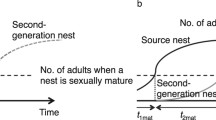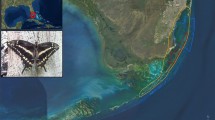Abstract
The red imported fire ant,Solenopsis invicta Buren, was identified as a key predator of the boll weevil,Anthonomus grandis Boheman. Although key factor analysis does not guarantee that the key factor is the causative agent, the evidence of boll weevil mortality was so clear that the fire ant could be identified as causing the mortality. Ant predation on immature boll weevils during the summer of 1981 averaged 84%. When this predation was combined with other natural mortality factors, the weevil population density throughout the season never exceeded levels that required control measures.
Résumé
La fourmi rouge importée,Solenopsis invicta Buren, a été identifiée comme prédateur majeur du charançon du cotonAnthonomus grandis Boheman. Bien que l'analyse des facteurs clés n'assure pas en soi que cet agent soit la cause directe des mortalités observées, l'action prédatrice des fourmis rouges fut telle que leur impact sur la mortalité des charançons a pu être clairement mis en évidence. Le taux de mortalité des larves d'A. grandis attribuable àS. invicta a été de 84% en moyenne pendant l'été 1981. Cette valeur, associée aux autres facteurs de mortalité naturelle, a permis de maintenir les populations de charançons en deçà des seuils nécessitant des mesures de contrôle.
Similar content being viewed by others
References
Bottrell, D.G. — 1976. The boll weevil as a key pest. In: Boll Weevil Suppression, Management, and Elimination Technology (Davich, T.B., ed). —Proc. ARS-USDA, 172 pp.
Coad, B.R. — 1915. Recent studies of the Mexican cotton boll weevil. —USDA Bull., 231, 34 pp.
Haynes, J.W. &Wright, J.E. — 1979. Fumigation of boll weevil pupae with bisazir to induce sterility. —J. Econ. Entomol., 72, 823–825.
Hinds, W.E. — 1907a. Proliferation as a factor in the natural control of the Mexican cotton boll weevil. —USDA Bur. Entomol. Bull., 59, 45 pp.
Hinds, W.E. — 1907b. Some factors in the natural control of the Mexican cotton boll weevil. —USDA Bur. Entomol. Bull., 63, 45–48.
Howe, R.W. — 1916. Studies of the Mexican cotton boll weevil in the Mississippi Valley. —USDA Bull., 358, 32 pp.
Hunter, W.D. & Coad, B.R. — 1923. The boll weevil problem. —USDA Farmers' Bull., 1329, 30 pp.
Jones, D. &Sterling, W.L. — 1979. Manipulation of red imported fire ants in a trap crop for boll weevil suppression. —Environ. Entomol., 8, 1073–1077.
Morris, R.F. — 1959. Single-factor analysis in population dynamics. —Ecology, 40, 580–588.
Morris, R.F. — 1965. Contemporaneous mortality factors in population dynamics. —Can. Entomol., 97, 1173–1184.
Podoler, H. &Rogers, D. — 1975. A new method for the identification of key factors from life-table data. —J. Anim. Ecol., 44, 85–114.
Price, P.W. — 1975. Insect Ecology. —John Wiley & Sons, New York, 514 pp.
Ricks, B.L. &Vinson, S.B. — 1970. Feeding acceptability of certain insects and various water-soluble compounds to two varieties of imported fire ant. —J. Econ. Entomol., 63, 145–148.
Smith, R.L. — 1980. Ecology and Field Biology. —Harper & Row, New York, 853 pp.
Solomon, M.E. — 1949. The natural control of animal populations. —J. Anim. Ecol., 18, 1–35.
Sterling, W.L. — 1978. Fortuitous biological suppression of the boll weevil by the red imported fire ant. —Environ. Entomol., 7, 564–568.
Sterling, W.L., Jones, D. &Dean, D.A. — 1979. Failure of the red imported fire ant to reduce entomophagous insect and spider abundance in a cotton agroecosystem. —Environ. Entomol.. 8, 976–981.
Taft, H.M., Hopkins, A.R. &James, W. — 1963. Differences in reproductive potential, feeding rate, and longevity of boll weevils mated in the fall and in the spring. —J. Econ. Entomol., 56, 180–181.
Varley, G.C. & Gradwell, G.R. — 1968. Population models for the winter moth. In: Insect Abundance (T.R.E. Southwood, ed). —Symp. R. Entomol. Soc. Lond., 4, 160 pp.
Author information
Authors and Affiliations
Additional information
This research was conducted in cooperation with SEA-USDA and supported in part by EPA grant No. R-806277030-01, titled “Development of Comprehensive, Unified, Economically, and Environmentally Sound Systems of Integrated pest Management for Major Crops” and Project H-2591 of the Texas Agricultural Experiment Station. Approved for publication as TA 18333 by Director, Texas Agricultural Experiment Station.
Rights and permissions
About this article
Cite this article
Fillman, D.A., Sterling, W.L. Killing power of the red imported fire ant [Hym.: Formicidae]: a key predator of the boll weevil [Col.: Curculionidae]. Entomophaga 28, 339–344 (1983). https://doi.org/10.1007/BF02372186
Issue Date:
DOI: https://doi.org/10.1007/BF02372186




